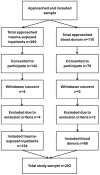Metabolic Syndrome and Associated Risk Factors in Norwegian Trauma-Exposed Inpatients: A Cross-Sectional Comparison with Blood Donors
- PMID: 40785753
- PMCID: PMC12333625
- DOI: 10.2147/DMSO.S536015
Metabolic Syndrome and Associated Risk Factors in Norwegian Trauma-Exposed Inpatients: A Cross-Sectional Comparison with Blood Donors
Abstract
Purpose: The incidence of metabolic syndrome (MetS) is increasing, and research indicates a further increased risk of MetS in trauma-exposed individuals, which is yet to be fully understood. Therefore, this study aimed to investigate the risk of MetS in trauma-exposed inpatients compared to blood donors and the influence of putative associated psychological, biological, and behavioral risk factors for MetS.
Patients and methods: A cross-sectional study of trauma-exposed inpatients (n = 134) compared to blood donors (n = 68) was conducted. Clinical data, blood biomarkers, and self-administered questionnaires were collected. Descriptive statistics and multivariable logistic regression, including interaction analyses, were performed to explore the odds ratio (OR) of MetS among trauma-exposed inpatients compared to blood donors as well as the interaction effects of putative risk factors.
Results: A significantly higher age- and gender adjusted OR (OR = 2.51, 95% CI 1.18-5.34) of MetS was found among trauma-exposed inpatients compared to the blood donors. Adjusted for education, cigarette smoking, symptoms of disordered eating and consumption of selected nutrients, the higher OR of MetS remained significant in the inpatients compared to the blood donors, ranging from OR = 2.27 95% CI 1.00-5.14 for symptoms of "dieting" to OR = 3.06 95% CI 1.16-8.10 for adult trauma. A significant interaction effect was documented only between group and age (OR = 1.07, 95% CI 1.01-1.13).
Conclusion: The trauma-exposed inpatients in this study had significantly higher age- and gender adjusted risk of MetS compared to the blood donors, and psychological and behavioral lifestyle factors appeared to increase the risk of MetS.
Keywords: disordered eating; insulin resistance; mental disorders; metabolism; posttraumatic stress; type 2 diabetes mellitus.
© 2025 Roer et al.
Conflict of interest statement
The authors report no conflicts of interest in this work.
Similar articles
-
Prevalence and determinants of metabolic syndrome among adults living with HIV on first-line antiretroviral treatment in southern Ethiopia: a cross-sectional study.Ther Adv Chronic Dis. 2025 Jun 21;16:20406223251346289. doi: 10.1177/20406223251346289. eCollection 2025. Ther Adv Chronic Dis. 2025. PMID: 40546308 Free PMC article.
-
Red cell distribution width/albumin ratio as a marker for metabolic syndrome: findings from a cross-sectional study.BMC Endocr Disord. 2024 Oct 25;24(1):227. doi: 10.1186/s12902-024-01762-7. BMC Endocr Disord. 2024. PMID: 39455980 Free PMC article.
-
The association between metabolic syndrome severity and frailty risk in patients with rheumatoid arthritis: a cross-sectional study.Arthritis Res Ther. 2025 Jul 10;27(1):145. doi: 10.1186/s13075-025-03612-w. Arthritis Res Ther. 2025. PMID: 40640879 Free PMC article.
-
Sertindole for schizophrenia.Cochrane Database Syst Rev. 2005 Jul 20;2005(3):CD001715. doi: 10.1002/14651858.CD001715.pub2. Cochrane Database Syst Rev. 2005. PMID: 16034864 Free PMC article.
-
Psychological therapies for children and adolescents exposed to trauma.Cochrane Database Syst Rev. 2016 Oct 11;10(10):CD012371. doi: 10.1002/14651858.CD012371. Cochrane Database Syst Rev. 2016. PMID: 27726123 Free PMC article.
References
LinkOut - more resources
Full Text Sources


